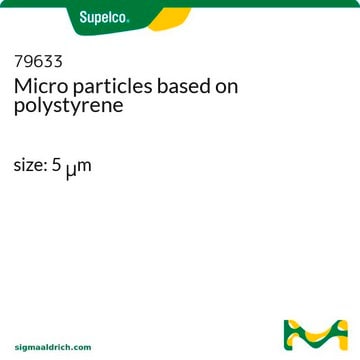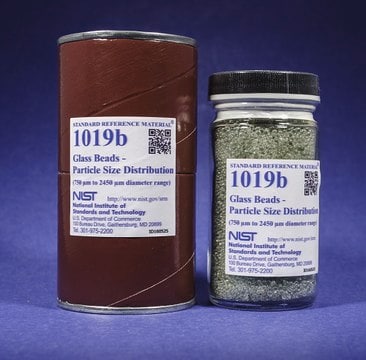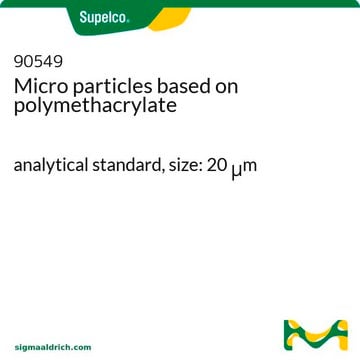44054
Micro particles based on silicon dioxide
size: 5 μm
Synonym(s):
Silica dioxide microsphere (5 μm), Micro silicon (5 μm), Beads based on silicon dioxide, microsize, Silicon dioxide beads
Sign Into View Organizational & Contract Pricing
All Photos(1)
About This Item
Recommended Products
grade
analytical standard
Quality Level
form
aqueous suspension
concentration
5% (solids)
particle size
5 μm std dev ≤0.35 μm
application(s)
glass & ceramic
industrial qc
pharmaceutical
format
neat
storage temp.
2-8°C
SMILES string
O=[Si]=O
InChI
1S/O2Si/c1-3-2
InChI key
VYPSYNLAJGMNEJ-UHFFFAOYSA-N
Looking for similar products? Visit Product Comparison Guide
General description
Silicon dioxide based microparticles are ideal to determine particle size distribution (PSD) profile of test samples.
The particle diameter of 5 μm is measured using Coulter Multisizer.
The particle diameter of 5 μm is measured using Coulter Multisizer.
Application
Used for regular calibration and checking of particle size instruments. Also used:
- to study transport properties of microscopic particles via heterogeneous media
- as a test standard to validate denoising method used in optical diffraction tomography
- in accelerated annealing experiments involving colloidal silica monolayers
- to evaluate the measurement accuracy of color-coded LED microscopy (cLEDscope) technique
- as a calibration standard in optical trapping system to measure surface mechanical properties
Features and Benefits
- suitable for routine instrument calibration monitoring, testing and corrections
- particle size traceable to Community Bureau of Reference (BCR) standards
- available in 5 mL pack size as a neat sample
Storage Class Code
10 - Combustible liquids
WGK
WGK 2
Flash Point(F)
Not applicable
Flash Point(C)
Not applicable
Personal Protective Equipment
dust mask type N95 (US), Eyeshields, Gloves
Choose from one of the most recent versions:
Already Own This Product?
Find documentation for the products that you have recently purchased in the Document Library.
Customers Also Viewed
Sophie Ramananarivo et al.
Nature communications, 10(1), 3380-3380 (2019-07-31)
Molecular motors are essential to the living, generating fluctuations that boost transport and assist assembly. Active colloids, that consume energy to move, hold similar potential for man-made materials controlled by forces generated from within. Yet, their use as a powerhouse
Dynamics and clogging of colloidal monolayers magnetically driven through a heterogeneous landscape.
Sergi Granados Leyva et al.
Soft matter, 16(30), 6985-6992 (2020-07-17)
We combine experiments and numerical simulations to investigate the emergence of clogging in a system of interacting paramagnetic colloidal particles driven against a disordered landscape of larger obstacles. We consider a single aperture in a landscape of immobile silica particles
Chansuk Park et al.
Journal of the Optical Society of America. A, Optics, image science, and vision, 35(11), 1891-1898 (2018-11-22)
Optical diffraction tomography (ODT) is a three-dimensional (3D) quantitative phase imaging technique, which enables the reconstruction of the 3D refractive index (RI) distribution of a transparent sample. Due to its fast, non-invasive, and quantitative imaging capability, ODT has emerged as
Cycle-consistent deep learning approach to coherent noise reduction in optical diffraction tomography
Choi G, et al.
Optics Express, 27(4), 4927-4943 (2019)
Single-exposure quantitative phase imaging in color-coded LED microscopy
Lee W, et al.
Optics Express, 25(7), 8398-8411 (2017)
Our team of scientists has experience in all areas of research including Life Science, Material Science, Chemical Synthesis, Chromatography, Analytical and many others.
Contact Technical Service






